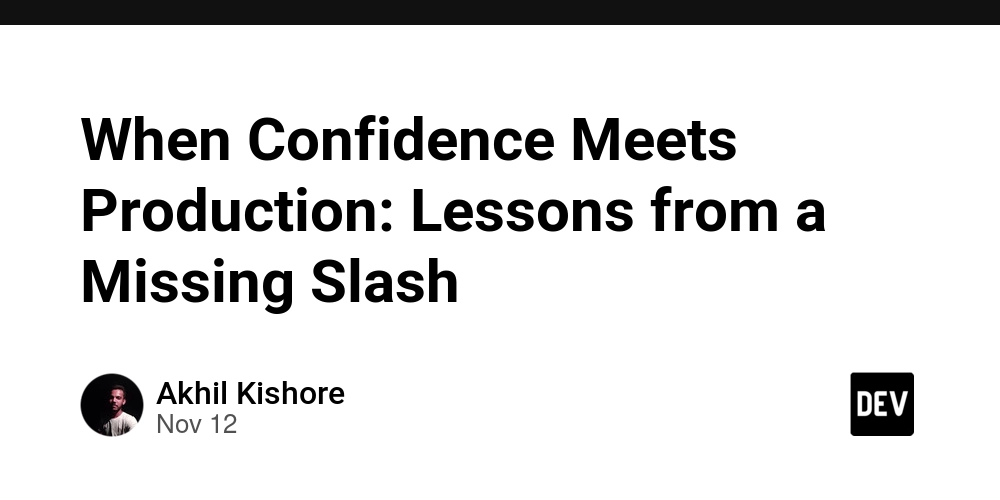Confidence Coverage: When 94% Tests Still Break Production
It was one of those Friday nights that make you feel invincible.
Every test passed. Every coverage metric gleamed above 90%.
The CI pipeline was all green — the kind of green that makes you think, “Yeah, we nailed it.”
As a senior engineer working in Trade Finance, where a single API call can move millions, that confidence felt well earned.
I had done my homework:
- Unit tests ✅
- Integration tests ✅
- Regression suite ✅
- Manual sanity ✅
I pushed to production, shut my laptop, and packed for a weekend trek up Agasthyakoodam.
Confidence? Sky-high. The kind that only comes from seeing everything green.
The Ping That Shattered the Peace
Saturday, 8:07 AM.
Fresh mountain air. Backpack on. First step up the trail.
📱 Buzz.
“Production is down. URGENT.”
I froze.
No signal. No backup. Just me, a laptop, and a mountain.
I climbed faster — not for the view, but for network bars.
By the time I reached 6,000 feet, I had a faint 4G signal.
Sitting on a rock, I opened my laptop to find the logs that would ruin my morning.
The Culprit: A Slash Too Few
The logs told a simple, painful story.
An API call failed — triggering a domino of retries, timeouts, and broken workflows.
The cause? A missing trailing slash in an environment variable.
Here’s what went wrong:
-
Staging: Host URL ended with a slash (
https://api.example.com/), endpoint started clean (status). ✅ -
Production: Host had no trailing slash (
https://api.example.com), endpoint began without one (status). ❌
When the two joined, the resulting URL was malformed.
The urljoin() call, which had behaved perfectly in staging, broke in production.
A single missing slash — and a multi-million-dollar workflow came to a halt.
My 94% test coverage didn’t see it coming.
The Illusion of Confidence
That was the day I learned:
Test coverage ≠ confidence coverage.
Unit tests make you feel safe.
Integration tests make you feel thorough.
But production? It humbles you.
Because:
- Mocks don’t drift. Real environments do.
- Test data behaves. Real data doesn’t.
- CI is clean. Configuration is chaos.
The irony? The tests weren’t wrong — they did their job.
They just didn’t prepare me for reality.
Why It Hurt More in Trade Finance
In Trade Finance, every integration layer is mission-critical.
Dozens of systems — banks, partners, repositories, regulators — all stitched together through APIs and assumptions.
A single malformed URL isn’t just a 500 error.
It’s a delay in document exchange.
A payment that doesn’t clear.
A customer commitment that slips.
When one link fails, the entire chain rattles.
And your “all green” test suite? It won’t catch it.
Confidence Coverage > Code Coverage
That morning on the mountain changed my mental model.
Forget chasing 100% code coverage — start measuring confidence coverage.
Confidence coverage is the degree of assurance that your system will behave correctly under real conditions, not just ideal ones.
It’s built through:
- Broader integration and end-to-end testing
- Environment consistency checks
- Automated configuration validation
- Continuous monitoring and alerting
- Load and chaos testing in staging
When you think in terms of confidence coverage, the question shifts from:
“How many lines are tested?”
to
“How sure am I that this won’t blow up in production?”
What I’d Tell My Younger Self
-
Testing isn’t about perfection — it’s about preparation.
Your tests won’t catch every failure, but they’ll teach you how to handle them gracefully. -
Environment parity matters more than coverage percentages.
A missing slash, a timeout, a wrong env var — these break real systems. -
Integrate early. Integrate often.
The earlier you touch real systems, the fewer weekend calls you’ll get. -
Monitor everything.
Tests prevent some fires. Monitoring tells you when one’s already burning. -
Confidence is good. Humility is better.
Every “impossible” bug reminds you: software at scale isn’t deterministic — it’s probabilistic with flair.
The View from the Peak
I fixed the issue right there on the mountain — half a battery, one patch, and a heavy dose of humility later.
The system came back up.
The trek continued.
The view at the top? Worth every step.
But something changed in how I saw engineering.
- Unit tests are your seatbelt.
- Integration tests are your guardrails.
- Monitoring is your lookout tower.
- And confidence? It’s the illusion you earn — until production reminds you who’s really in charge.



